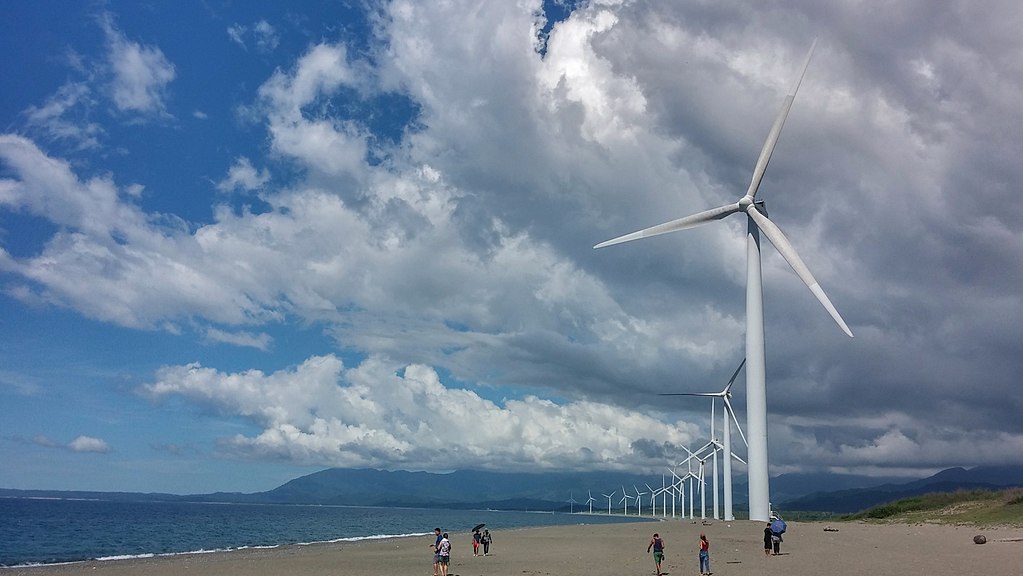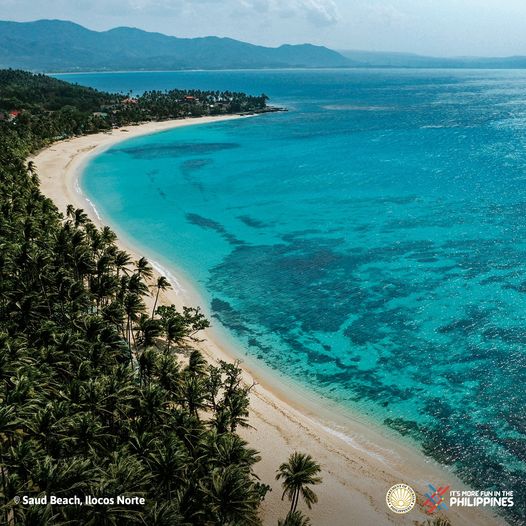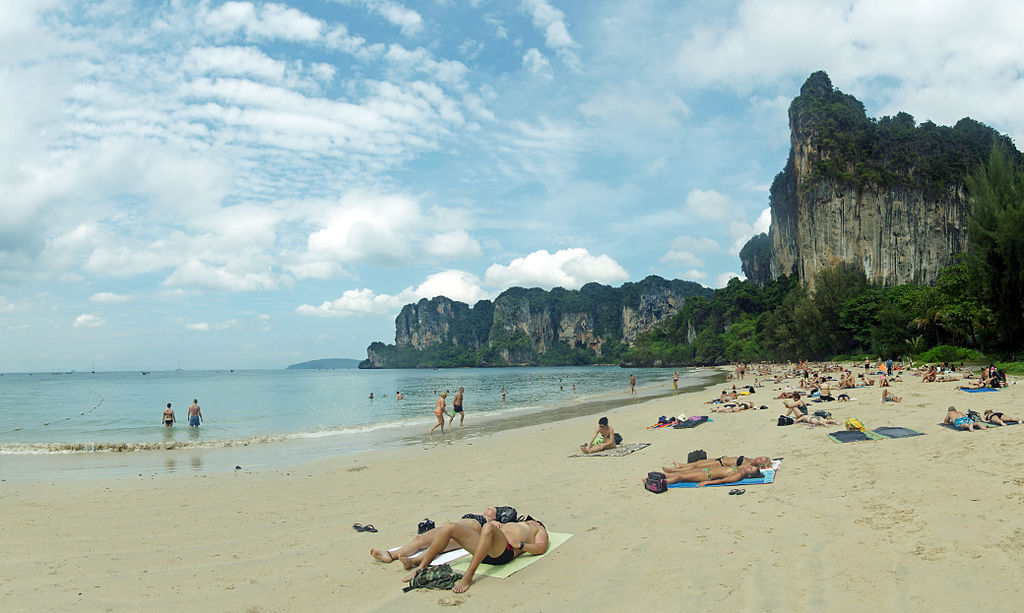Dear foreign readers, do you know that there are six operational wind farms in the Philippines? Allow Tita S to tell you about one (of three) which is located in Ilocos Norte.
Yes, there are 3 wind farms in this province. Ilocos Norte1 is blessed with regular North Westerly winds because of its strategic location in the northwestern tip of the Luzon island group at the northern part of the Philippines.
Anyway, let me tell you about Bangui Wind Farm. It is a wind farm located in the town of Bangui2, in the province3 of Ilocos Norte1, in the Ilocos4 Region5, in the northwestern part of the island group of Luzon, at the northernmost part of the Philippine archipelago.

Photo source: Jesstine Co, own work, CC BY-SA 4.0, created 10 June 2017, https://en.wikipedia.org/wiki/Ilocos_Norte#/media/File:Bangui_Windmill.jpg
It is the Philippines’ oldest wind farm and the first power-generating wind farm in Southeast Asia. The undeveloped and uninhabited area is devoid of trees and vegetation and does not pose any threat to the environment.

Photo source: Iandelgado, own work, CC BY-SA 3.0, created 24 September 2010, https://en.wikipedia.org/wiki/Bangui,_Ilocos_Norte#/media/File:Bangui_windmills.jpg
This wind farm is more accessible and popular than the two other wind farms in the province – the Burgos Wind Farm in the town of Burgos, and Caparispisan Wind Farm in the town of Pagudpod.
It uses 20 units of 70-m (230 ft) high Vestas6 V82 1.65 MW wind turbines, arranged in a single row, stretching along a 9-km (5.6 mi) shoreline off Bangui Bay, facing the West Philippine Sea.

Photo source: https://www.facebook.com/TourIlocosNorte/photos/3560424750700751
The wind turbines are dubbed as Ilocos Norte’s giant electric fans. Each wind turbine has 3 vertically-oriented rotor blades on top of a high tubular tower, with a 6-m diameter base. This wind generating equipment is expected to last for 21 years.
This wind farm project started with an aid grant of US$48 million from the Danish government to the province of Ilocos Norte1 in 1998.
It was inaugurated on June 18, 2005, and was commissioned on June 20, 2005. It is owned by the NorthWind Power Development Corporation which developed, and now maintains and operates, the wind farm. The Danish firm Vestas Wind Systems supplied the wind turbine-generator units (WTGs) for the site, similar to those found in Denmark. Since then, this wind farm project has become a popular tourist attraction of the province.
This project was ratified by the NorthWind Power Development Corporation and the International Bank for Reconstruction and Development through the World Bank Prototype Carbon Fund. It is the first project in the Philippines to have the Emissions Reduction Purchase Agreement (ERPA) under the Clean Development Mechanism. It is also the first Philippine recipient of the Carbon Emission Reduction Certificates (CER’s) from the Executive Board of the United Nations Framework Convention on Climate Change.
The first phase, which amounted to US$23 million, consisted of 15 70-m (230 ft) high, on-shore wind turbines, each with a maximum production capacity of 1.65 MW of electric power, for a total of 24.75 MW. They were spaced 326 m (1,070 ft) apart, with 41 m (135 ft) long blades, with a rotor diameter of 82 m (269 ft) and a wind-swept area of 5,281 sqm (56,840 sq ft).
These wind turbines face Bangui Bay where the prevailing northwesterly and southwesterly winds blow inland. Their location along the shore is optimal due to a lack of windbreaks and limited terrain roughness. Phase I was completed on May 7, 2005, and generated 24.74 MW.
Phase II added 5 more of the same wind turbines and was completed on August 2008, for a total 20 operational wind turbines, a total maximum capacity of 33 MW, transmitting 5.7 km (3.5 mi) to an electrical substation in Laoag City. Connected to the Luzon Grid, this wind farm supplied 40% of Ilocos Norte’s electricity needs, through the Ilocos Norte Electric Cooperative (INEC).
In 2018, this wind farm expanded and was able to provide 50%, or 33 MW, of Ilocos Norte’s electricity. As of September 2020, Bangui Wind Farm had a total of 26 wind turbines, capable of producing electricity up to a maximum total generating capacity of 41 MW.
The Bangui Wind Farm was also Southeast Asia’s largest wind farm when it opened in 2005 until 2014, when nearby Burgos Wind Farm opened, with 150 MW.
The wind power produced in this farm is bought by INEC, which covers 23 municipalities and Laoag City. INEC purchases the electricity created through a 20-year Energy Sales Agreement (ESA) at a discount to the typical rate, and those savings are passed on to consumers.
This wind farm estimates that almost 57,000 tons of CO2e (tons of carbon dioxide equivalent) of greenhouse gases will be reduced per year for the duration of the project. That is 1.2 million tons of Carbon Dioxide! Talk about sustainable and renewable energy! This gives Ilocos Norte one of the lowest carbon emission footprints in Asia, when combined with hydro-electric power generation.
Would you believe that the shores where this wind farm is located is a precious place where the critically endangered hawksbill sea turtles lay their eggs, up to 150 eggs in a nest at a time? Local environmental officials have been monitoring the stretch of the shoreline for sea turtle nesting areas. The provincial fishery division of the provincial government and local government units have included in their information campaigns the conservation and protection of this endangered species. NorthWind Power Development Corporation which holds the lease within the foreshore area has commissioned people to look after the nests during nesting season to protect them from predators and poachers.
So, how do you get to Bangui to see this wind farm? From Metro Manila, you can fly to Laoag City’s International Airport, about 1 hour and 20 minutes. From there, a group can hire a van and head straight to Bangui2.
Those on a budget can ride a bus from Metro Manila to Laoag, but the ride is about 10-12 hours, so why not take the evening trip? Next, take another bus from Laoag to Bangui town proper for about 1 1/2 hours, then hire a tricycle to the Bangui Wind Farm and nearby attractions, for about PHP300.
You can also use your own vehicle to drive from Metro Manila to Bangui2, at a travel time of 11 – 14 hours depending on traffic and stopovers. Just follow the Pan-Philippine Highway, and pass through the towns of Bacarra, Pasuquin and Burgos. From the latter, look out for directional signs leading to the wind farm, and Tita S is sure that eventually, the wind turbines will be very visible from the highway. Make a left turn a few meters after passing the Burgos Wind Farm. Drive straight ahead until you reach Estrells’ Place Resort, then turn right.
You also have the option to join a 4-D 3-N package tour of Ilocos Norte1, just google options.
By the way, there is no entrance fee to visit this clean and green wind farm. You can walk from one turbine to another and take as many pictures as you want. They say that if you do not want to walk, you may opt to ride around with a horse for only PHP100.
It is recommended that you visit this wind farm early morning or nearing sunset so it will not be too hot for you, and have great sunrise or sunset shots, along the shores of the Bangui Bay.
It would be best to wear closed footwear to avoid collecting sand after your walk. If it is a windy day, better protect your legs by wearing pants for possible small stones blown by the wind. Protect your face, if need be, too.
There is a restaurant where you can enjoy coffee and snacks while looking at the wind turbines’ rotating blades.
I was told that there are a couple of air-conditioned huts where you can stay overnight if you want some alone-time for some peace and quiet away from the city, or just meditate, synced with the circular motion of the wind turbines’ blades.
This wind farm also boosted local farmers to sell onions and garlic in roadside stalls, and small entrepreneurs to sell souvenirs like wooden replicas of the wind turbines, pin wheels, keychains, etc.
The information was obtained from http://www.pagudpud-ilocos.com/bangui-windmills.html,
https://primer.com.ph/travel/2017/03/07/bangui-wind-farm/, https://www.facebook.com/pages/Bangui-Wind-Farm/370956566282893,
http://alternergy.com/33mw-bangui-bay-wind-farm/,
https://www.ph.arteliagroup.com/Services/bangui-bay-wind-farm/,
https://app.philippines.travel/experiences/bangui-windmill-farm,
https://newsinfo.inquirer.net/563477/ilocos-wind-farm-hosts-endangered-turtles-too?fbclid=IwAR1yiA4aLqKsTGpLTWFZfMYaTnj90erq7hGDOy4O4EraAMLTi38A7cgYUOE and the Wikipedia pages “Bangui Wind Farm”7, “Wind power in the Philippines”8, “Wind power by country”9, and “List of power plants in the Philippines”10.
Your Ilocos Norte1 trip will not be complete without going to Bangui Wind Farm. So, better include it in your itinerary. See footnote 1 below for the popular tourist attractions of this province that you can include in your Ilocos Norte travel bucket list.
I have not been to this wind farm but have visited Ilocos Norte1 during my college days. So, the next time I visit this province, I will include the 3 winds farms and tell you about them.
This is not a sponsored post. I just want my readers to know more about the Philippines.
Did you find this post informative? I would like to hear your comment/s regarding Bangui Wind Farm, especially if you were able to see it.
See other interesting places through other posts in this category and other categories of SCapades, Pinoy Delights, and Smart Traveler – Now You Know, Short and Simple, and Say, Say, Say. Happy reading, and I hope that you will appreciate what I shared and some of the featured destinations will be part of your future travel plans!
Remember to share this post with your friends, follow me by clicking on the bottom right corner of your device, and do not forget to like this post. Thank you.
– – – – – – – – – – – – – – – – – – – – – – – – – –
The following terms are defined for interested readers, especially those with “Senior-Moments”, those not familiar with Filipino terms, and those too busy or lazy to Google such terms:
1Ilocos Norte is a province3 in the northern tip of the Ilocos4 region5, in the northwestern part of the island group of Luzon, at the northernmost part of the Philippine archipelago. It covers a total area of 3,467.89 sq. km. (1,338.96 sq. mi.). It is bordered by the Luzon Strait to the north, the West Philippine Sea to the west, Ilocos Sur to the southwest, Cagayan to the northeast, Apayao to the east, and Abra to the southeast. It was founded in 1818 and its capital is Laoag City. It consists of 21 towns and 2 component cities11 (Batac and Laoag).
This province boasts of the following popular tourist attractions: Fort Ilocandia Resort Casino; the Paoay Lake golf course designed by Gary Player for President Ferdinand Marcos in 1977; the La Paz Sand Dunes for sandboarding and 4×4 vehicle riding; the Malacañang of the North which was the family 2-storey mansion-residence of the family of President Marcos when he was president and is now a presidential museum; the 1892 Cape Bojeador Lighthouse where early galleons used to sail by during the Spanish colonial period (1565 – 1898) in the Philippines; the 3 wind farms (in the towns of Bangui. Burgos and Caparispisan); Kapurpurawan Burgos Rock Formation for its creamy white limestone formations sculpted by wind, waves and sedimentation over thousands of years; the 1612 45-m (150 ft) Sinking Bell of Laoag, sinking 1-inch a year because it is so heavy and was built on sandy formations; St. Augustine Church or Paoay Church, a UNESCO World Heritage Site under the collective group of Baroque Churches of the Philippines in 1993, and a national Cultural Treasure; Museo Ilocos Norte, a museum which has a large collection of Ilocano, Igorot and Itneg traditional clothing and artifacts and special exhibits; Batac Museum or Marcos Museum dedicated to President Marcos; and Saud Beach in the town of Pagudpud.
See my post about Saud Beach: SAUD BEACH (Pagudpud, Ilocos Norte, Philippines)
The information was obtained from http://www.pagudpud-ilocos.com/laoag-sinking-bell-tower.html, https://guidetothephilippines.ph/articles/what-to-experience/laoag-tourist-spots, https://en.wikipedia.org/wiki/Paoay_Church and the Wikipedia page “Ilocos Norte.”12
2Bangui is a town (called a municipality in the Philippines) in the province3 of Ilocos Norte1, in the Ilocos4 Region5 of the Philippines. It has a total land area of 112.98 sq. km. (43.62 sq. mi.), with 14 barangays13.
It became a popular tourist destination because of the Bangui Wind Farm, along Bangui Bay. Unfortunately, you cannot swim in the latter because of its deepness and water currents, so just appreciate its beauty from the Bangui Bay Viewing Building.
Other tourist destinations include: Abang Falls, Baruyen Dam, Bolo River (or Caramuangen River), Sentinella Hill, Suacan Spring, and the municipal plaza.
The information was obtained from the Wikipedia page “Bangui, Ilocos Norte”.14
3A province is the primary administrative and political division in the Philippines. It is the second-level administrative sub-division of a region5. There are 81 provinces (called lalawigan) in the Philippines. Each province is governed by an elected legislature called the Sangguniang Panlalawigan, and by an elected governor. Remember, a province in the Philippines is divided into cities and towns (called municipalities), which in turn, are divided into barangays13, formerly called barrios. The information was obtained from Wikipedia page “Provinces of the Philippines.”15
See a related post: Foreign Seniors Ask: WHAT ARE PROVINCES IN THE PHILIPPINES?
4The Ilocos Region, or Region 1, is an administrative region5 of the Philippines which occupies the northwestern section of the Luzon group of islands in the northernmost part of the Philippine archipelago. It is bordered by the South China Sea to the west, Cagayan Valley Region to the northeast and southeast, Cordillera Administrative Region to the east, and the Central Luzon Region to the south.
It has a total area of 13,012.6 sq. km. (5,024.19 sq. mi). It comprises 4 provinces3 – Ilocos Norte1, Ilocos Sur, la Union and Pangasinan, and a total of 116 towns. Its regional center is the city of San Fernando (in La Union). It has 1 independent city16 – Dagupan City, and 8 component cities11 – Alaminos, Batac, Candon, Laoag, San Carlos, San Fernando, Urdaneta and Vigan. Most residents speak Ilocano.
The information was obtained from Wikipedia page “Ilocos Region.”17
5A region is an administrative division based on geographical, cultural and ethnological characteristics. Each region is further subdivided in provinces3, composed of cities and towns (called municipalities), which in turn, are divided into barangays13, formerly called barrios, according to Wikipedia page “Regions of the Philippines” 18.
See a related post: Foreign Seniors Ask: WHAT ARE THE REGIONS OF THE PHILIPPINES?
6Vestas Wind Systems A/S is a Danish manufacturer, seller, installer and servicer of wind turbines, with headquarters in the city of Aarhus. It was founded in 1945 by Peder Hansen. It operates manufacturing plants in Denmark, Australia, Brazil, China, Germany, India, Italy, the Netherlands, Norway, Poland, Romania, Spain, Sweden, Taiwan, the United Kingdom, and the USA.
As of 2013, it is the largest wine turbine company in the world. It has installed over 66,000 wnd turbines for a capacity of 100 GW, in over 80 countries, on 5 continents, as of 2019.
The information was obtained from Wikipedia page “Vestas.”19
7“Bangui Wind Farm,” accessed February 20, 2021, https://en.wikipedia.org/wiki/Bangui_Wind_Farm
8“Wind Power in the Philippines,” accessed February 20, 2021, https://en.wikipedia.org/wiki/Wind_power_in_the_Philippines
9“Wind power by country,” accessed February 20, 2021, https://en.wikipedia.org/wiki/Wind_power_by_country
10“List of power plants in the Philippines,” accessed February 20, 2021, https://en.wikipedia.org/wiki/List_of_power_plants_in_the_Philippines
11A component city is a type of city in the Philippines which does not meet the requirements of a highly urbanized city (see footnote 12). It is under the jurisdiction of a province3. If such a city is located along the boundaries of 2 or more provinces, it shall be considered part of the province of which it used to be a municipality (town). The information was obtained from Wikipedia page “List of cities in the Philippines.”20
12“Ilocos Norte,” accessed February 20, 2021, https://en.wikipedia.org/wiki/Ilocos_Norte
13A barangay in the Philippines is the smallest administrative division in the Philippines, headed by a barangay captain, aided by a Sangguniang Barangay (Barangay Council). It is the native Filipino term for a village. It was formerly called a barrio. In a metropolitan area, a barangay is an inner city neighborhood, a suburb, or a suburban neighborhood. The word barangay originated from the term balangay, a kind of boat used by a group of Austronesian people who migrated to the Philippines. A number of barangays grouped together is called a district. The information was obtained from Wikipedia page “Barangay.”21
14“Bangui, Ilocos Norte,” accessed February 20, 2021, https://en.wikipedia.org/wiki/Bangui,_Ilocos_Norte
15“Provinces of the Philippines,” accessed May 29, 2019, https://en.wikipedia.org/wiki/Provinces_of_the-Philippines
16An independent city in the Philippines has 3 major characteristics: its Sangguniang Panlungsod (the city’s legislative council composed of councilors, with the vice mayor as presiding officer) legislation is no longer subject to review by any province’s Sangguniang Panlalawigan (the provincial council/board; the provincial legislative branch); it stops sharing its tax revenue with any province; and, the President of the Philippines exercises direct supervising authority over the city government.
It can be classified as either:
* highly urbanized city – a city with a minimum population of 200,000 inhabitants, as certified by the Philippine Statistics Authority, and with the latest annual income of at least PHP50 million (USD1 million), as certified by the City Treasurer; or,
* independent component city – a city which is independent from the province in which it is geographically located, and residents cannot vote for provincial officials; there are only 5 – Cotabato, Dagupan, Naga (Camarines Sur), Ormoc and Santiago.
The information was obtained from Wikipedia page “List of cities in the Philippines.”20
See a related post: Foreign Seniors Ask: HOW MANY CITIES ARE THERE IN THE PHILIPPINES?
17“Ilocos Region,” accessed February 20, 2021, https://en.wikipedia.org/wiki/Ilocos_Region
18“Regions of the Philippines,” accessed July 17, 2018, https://en.wikipedia.org/wiki/Regions_of_the_Philippines
19“Vestas,” accessed February 20, 2021, https://en.wikipedia.org/wiki/Vestas
20“List of cities in the Philippines,” accessed April 2, 2018,
https://en.wikipedia.org/wiki/List_of_cities_in_the_Philippines
21“Barangay,” accessed December 30, 2018, https://en.m.wikipedia.org/wiki/Barangay






